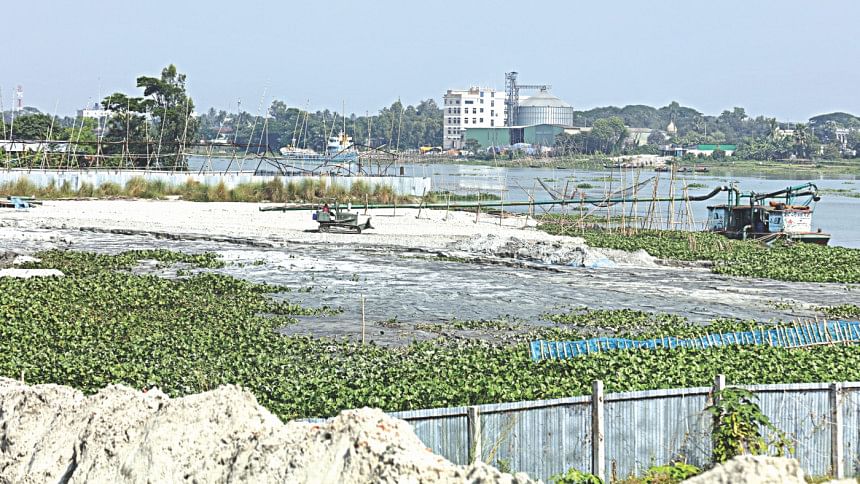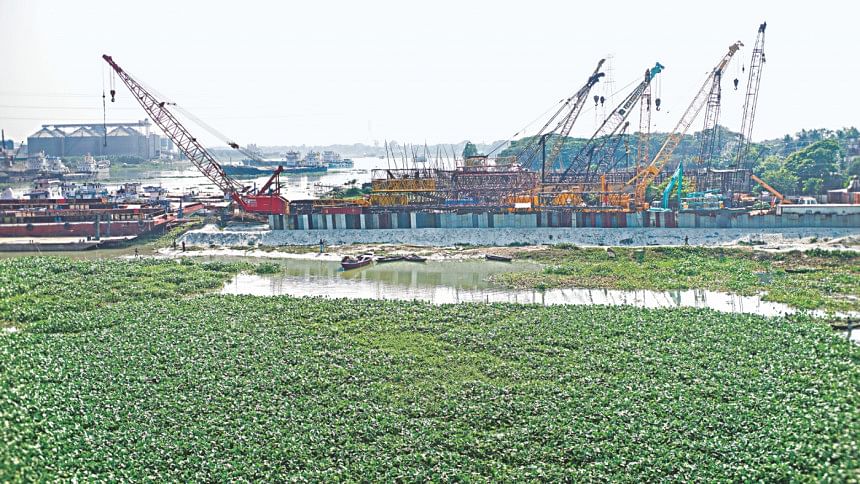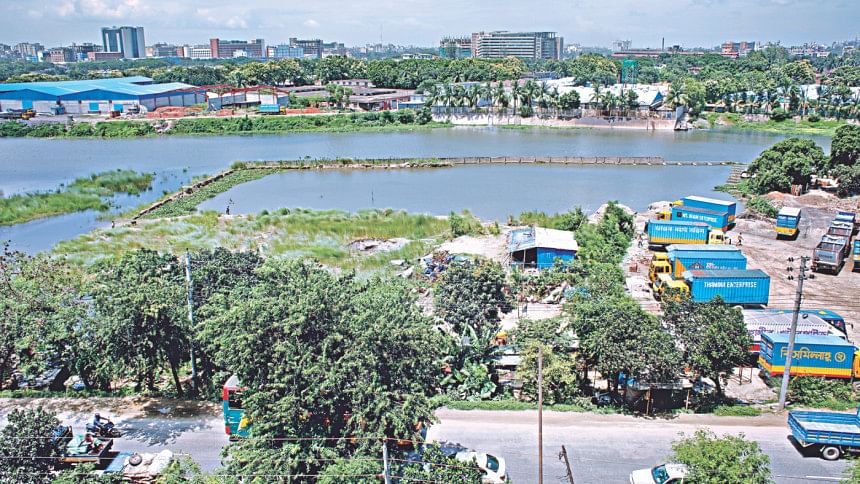2009 HC Verdict: What the court directed and what’s been done

The apex court in 2009 directed the government to demarcate the original territory of the four Dhaka rivers -- Buriganga, Turag, Balu Shitalakhya -- restore those rivers to their original state and protect them against grabbing and from pollution.
The government, the constitutional trustee of the country’s rivers, has been silent and various river custodians have been indifferent to their duties, the court observed.
Ascertaining the river boundary was the foremost job, but no authorities could demarcate the exact boundary of the rivers.
All the authorities including district administrations, BIWTA, land survey directorate and environment department admitted that the actual expanse of the rivers could be traced in the CS records and maps.

Take the CS records and maps as the primary basis of river boundary, the court observed.
What else did the HC say and what has been done so far?
HC DIRECTIVES AND IMPLEMENTATION
Surveys: Four deputy commissioners of Dhaka, Narayanganj, Gazipur and Munshiganj were directed to conduct and complete the river survey on the basis of both CS and RS records and maps along with Land Rerecords and Survey Department by the end of 2009. And then, all the river lands, other than what had been leased out legally, had to be identified and demarcated with boundary pillars by November 2010 to keep those under absolute ownership and control of the government
The job, however, has been controversial and remained incomplete.
Demarcation pillars: With most of the extensive river foreshore lines controversial, the authorities went ahead with installation of 9,577 boundary pillars on the existing river. Now, the government is set to discard all of those and has undertaken an ambitious project to set up pillars afresh, with the foreshore lines still undetermined as per CS records.
Walkway: According to official claims, 22kms walkways have been built in a fragmented fashion in Kanchpur, Shyampur, Dharmaganj, Ramchandrapur and Tongi. The total length was supposed to be over 200kms.
Disclosure of legitimate leaseholders of river land: The district administrations were directed to make public the details of the legally leased out river’s Char land, enumerate the area of land, identify the authority that leased out the land and the lease holders, and publicise the term of tenancy by end of 2010. It was necessary because foreshore and shoals are Khas (public) lands and integral to rivers.
No such lists, however, has been made public yet.
Eviction of illegal occupants: The verdict made the immediate eviction without discrimination of illegal occupants and recovery of river’s Khas land a must. The government was directed to take legal action under the Code of Criminal Procedure for the offence of river grabbing.
Some intermittent eviction drives have been carried out, but most were without a complete list of grabbers and without specific survey results, according to officials.

Handover of rivers’ port limit: In view of the river conservation, the land ministry would have to hand over the port limit of four rivers -- Buriganga, Shitalakhya, Turag and Balu -- to the BIWTA as part of three inland river ports in accordance to the government’s gazette notification of October 19, 2004.
BIWTA Joint Director AKM Arif Uddin said that the port limit of the said rivers has not yet been handed over to BIWTA. Since the verdict, the joint survey of rivers by DCs and BIWTA has not been accomplished. As a result, the DCs could not even make the handover proposal to the land ministry.
The length and breadth of the port area: The port limit of Shitalakhya river would stretch up to Murapara (Rupganj) to the north and Gopchar to the south and 50 yards above the high-water mark on both east and west banks during ordinary spring tide.
The Buriganga and Turag would stretch up to the south and Ashulia to the north and 50 yards above the high-water mark on the banks of both Buriganga and Turag during ordinary spring tide, as they flow above-mentioned north and south limits.
The Balu and part of Turag river would stretch up to Ashulia to the west and Demra to the south and 50 yards above the high water-mark of both banks of the Turag river, Tongi Khal and Balu river during ordinary spring tide.
Excavation of river sources: Excavating the sources of all four rivers to augment water flow was directed in the verdict or, the court apprehended, within the next decade the capital city would face an acute water crisis with the ground water table consistently depleting.
The court directed the government to dredge the river sources to get water from the Jamuna into the Dhaleswari, from Dhaleswari to Buriganga, and from the old Brahmaputra to the Bangshi river and bring back navigability in the four rivers.
Leaving the four rivers in deplorable state, the government has undertaken multiple million-dollar water projects using foreign loans to fetch water for the capital from far away Meghna and Jamuna rivers that too have got mired in alleged corruption and snail-like progress.
Dredging of Jamuna-Dhaleswari, Dhaleswari-Buriganga, Old-Brahmaputra-Bangshi, Bangshi-Turag river systems and Pungli and Tongi canals was yet another notable directive.
Removal of earth: The court directed removal of illegal sand and earth which were used to fill in the river and the government would have to realise the cost of it from the grabbers.
The rivers, however, are yet to be freed of sand and earth filling.
Ecologically Critical Area: The environment department in keeping with the verdict declared the four rivers ecologically critical area. But ruthless filling up and pollution have been going on simultaneously as well.
Dredging and sludge removal: A few mere superficial and futile moves of dredging and sludge removal from the river bed once or twice were made following the verdict. Those, however, yielded no tangible result nor any difference, said officials.
Tree plantation: The government was directed to plant trees along the demarcated river edge in a bid to protect the river area within one year since delivery of the judgment. This, too, has not been done properly.
Freeing Bukland embankment: The 1.5km Bukland Bund (embankment) on the Buriganga is yet to be free of Badamtoli fruit market and Shyampur vegetables market.
AN EFFECTIVE COMMISSION
The dilemma of minister-led task force and the National River Conservation Commission: The apex court emphasised instituting an effective national river commission that the government has put in place.
The government in mid-2014 formally launched the National River Protection Commission with much fanfare as the highest authority with a vow to save the country’s ailing rivers.
But a fundamental loophole in the law made that commission a recommending body without any executive power, said officials.
The law makes the commission an advisory body to recommend actions to conserve rivers, say river experts, and has nothing much to do in case such recommendations are ignored.
The government also runs a national task force on rivers led by the state minister for shipping with almost similar mandate parallel to the river commission.
Then, yet another bench of the apex court in a February judgement this year, a decade later, had to declare the river commission as the legal guardian of country’s rivers to establish its supremacy as the river custodian.
The court further directed the government to amend the commission law and incorporate stringent provisions for imprisonment and hefty fines to empower the commission to contain offences against rivers.

 For all latest news, follow The Daily Star's Google News channel.
For all latest news, follow The Daily Star's Google News channel. 



Comments